The rapid growth of information, communication and entertainment technology sectors is ratcheting a viral effect on the manufacturing industries, leading to phenomenal growth in volume, variety and applications. The booming demand, rapid changes in technology, media (tapes, software, MP3), falling prices and planned obsolescence are resulting in the fast growth of e-waste.
Electronic and electrical equipment (EEE) when discarded is called e-waste. These include discarded computers, office electronic equipment, electronic entertainment devices, mobile phones, television sets, refrigerators, microwave ovens and electric appliances and devices, among others. India is likely to generate three million metric tons (MT) of e-waste per year by 2018 from the present 1.85 million MT, as per an ASSOCHAM-Frost & Sullivan study. Mumbai with 120,000MT tops the list followed by Delhi-NCR (98,000MT) and Bengaluru (92,000MT).
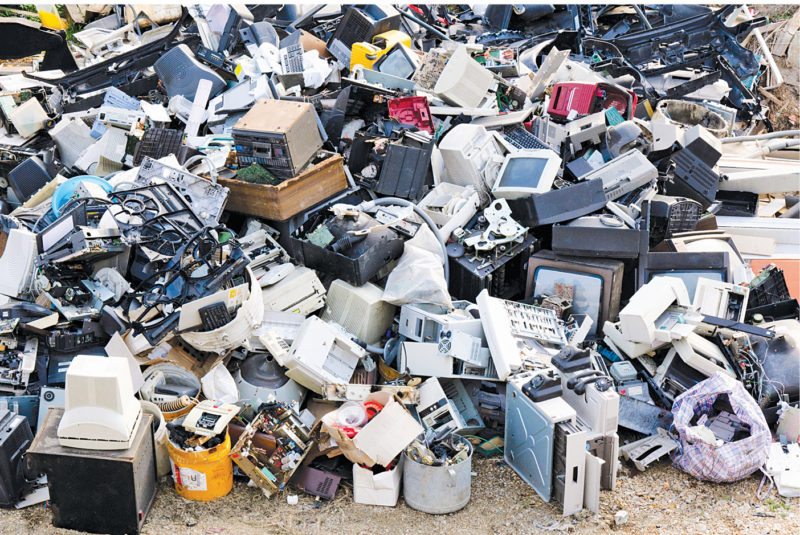
The study also points out that Chennai, Kolkata, Ahmedabad, Hyderabad and Pune are generating 67,000MT, 55,000MT, 36,000MT, 32,000MT and 26,000MT of e-waste per year, respectively. Computer equipment accounts for almost 70 per cent of e-waste material, followed by telecommunication equipment (12 per cent), electrical equipment (eight per cent) and medical equipment (seven per cent). Other equipment such as household e-scrap account for the remaining four per cent.
This estimate includes second-hand equipment and devices imported from developed countries for reuse, which mostly end up in unauthorised recycling yards either immediately or once the re-used product is discarded. Complex and ambiguous definitions of second-hand electronic equipment has made it difficult for the customs department to trace, identify and stop the illegal inflow of e-waste into the country. The government recently informed Apple that it will not allow import and sale of second-hand consumer products as it contributed to electronic waste being dumped in India. The discard rate of EEE is shown in Table I.
Most businesses and individuals sell their discarded EEE to informal recyclers for ease and ready money without realising the hazardous implications it causes to health and environment. Also, dumping EEE directly in the trash bin is equally hazardous to the environment. Exchange offers for old devices are one of the ways for proper disposal of EEE. Most consumer electronics brands such as LG, Microsoft, Panasonic, Philips, Samsung, Sony and Whirlpool provide such offers from time to time. For this purpose they have local collection centres.
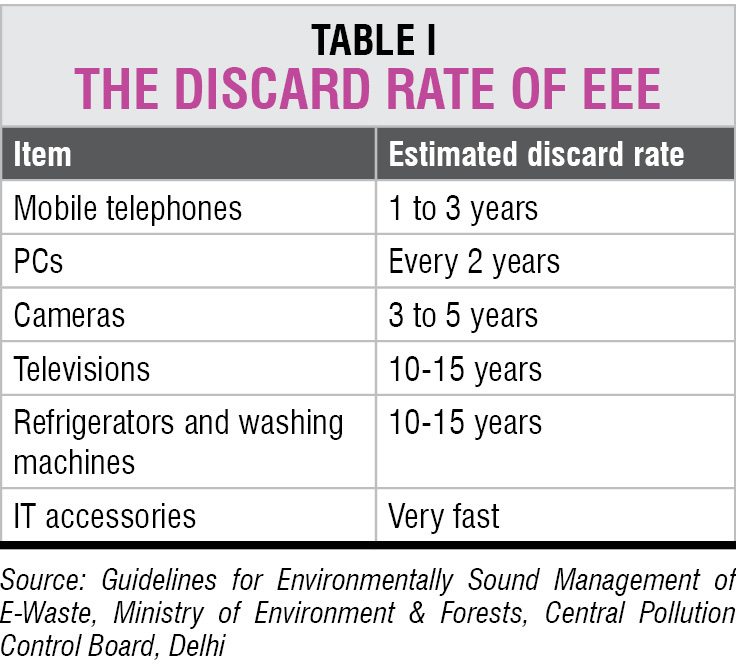
Recycling and disposal practices
e-Waste is much more hazardous than domestic, general-industry and municipal wastes because of thousands of components made of highly-hazardous chemicals and metals like lead, cadmium, chromium, mercury, polyvinyl chlorides, brominated flame retardants, beryllium, antimony phosphors (not to be confused with phosphorus) and phthalates.
Generally, EEE comprise 50 per cent steel, 21 per cent plastic and 14 per cent non-ferrous metals, which include precious metals like gold, platinum and silver. Apple revealed in recently-released environmental responsibility report that it has reclaimed almost one metric ton of gold, three tons of silver and over 1300 tons of copper by recycling its own products in 2015.
Due to the presence of hazardous chemicals and toxic substances, disposal of e-waste has become an environmental and health nightmare. More than 95 per cent of e-waste generated is managed by the unorganised sector and scrap dealers in India. Only 2.5 per cent of India’s total e-waste gets recycled because of poor infrastructure and legislative framework, leading to waste of diminishing natural resources, irreparable damage to environment and health of the people. Recycling involves sorting, dismantling and recovery of valuable materials. Typical materials recovered from refrigerators are shown in Table II.
How e-waste is polluting the environment and affecting human health
Most of the e-waste either ends up in landfills or unauthorised recycling yards where dismantling of e-waste is done in an unorganised and unscientific way to reclaim precious metals like gold and silver. Incineration by unqualified e-waste disposers could release toxins into the air. After recovery of items with value, remaining materials are thrown in rivers, drains or disposed of in solid waste dumps, which adds to environment pollution.
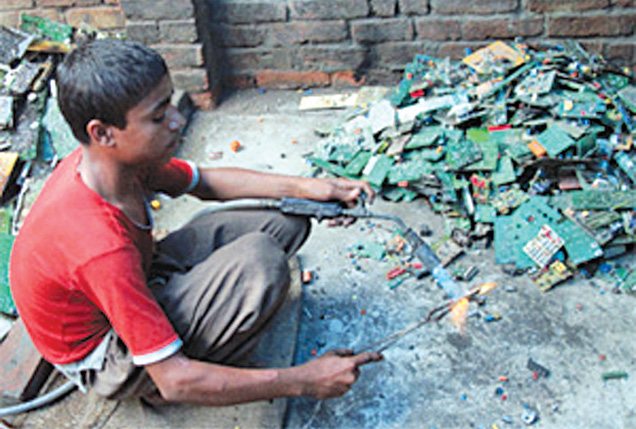
Liquid and atmospheric releases end up in bodies of water, groundwater, soil and air. Hazardous chemicals including deadly dioxins and furans have been reported where recycling takes place.
Recycling and disposal of e-waste usually results in serious health and pollution problems and significant risk to workers and communities. Long-term exposure damages the nervous system, kidneys, bones and the reproductive and endocrine systems, and some of these are carcinogenic and neurotoxin. Great care needs to be taken to avoid unsafe exposure in these operations and leaking of materials from landfills and incinerator ashes.
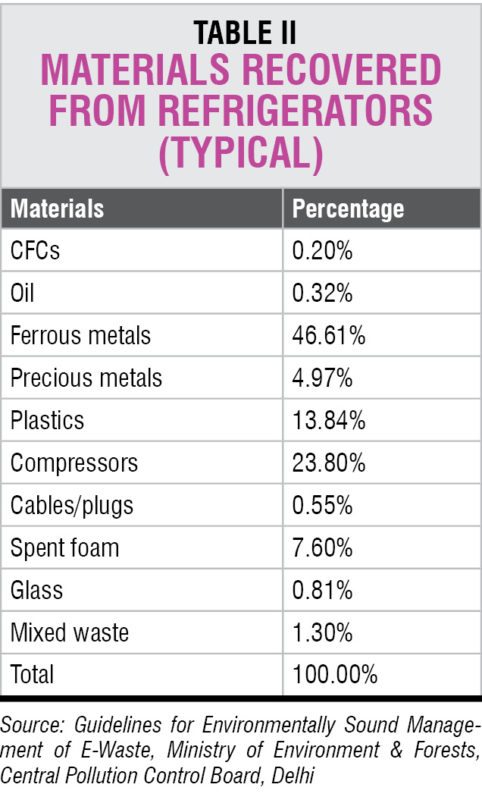
e-Waste toxins and body parts affected by these are shown in Table III. It is estimated that nearly 500,000 child labourers in the age group of 10 and 14 years are engaged in various unauthorised e-waste activities, without adequate protection and safeguards in various yards and recycling workshops. There are 148 registered e-waste dismantling/recycling units with an estimated total capacity of 450,000 per annum—a huge gap between waste generation and dismantling/recycling capacity. Karnataka has the maximum number (52), followed by Maharashtra (24), Tamil Nadu (16), Uttar Pradesh (16) and Haryana (14).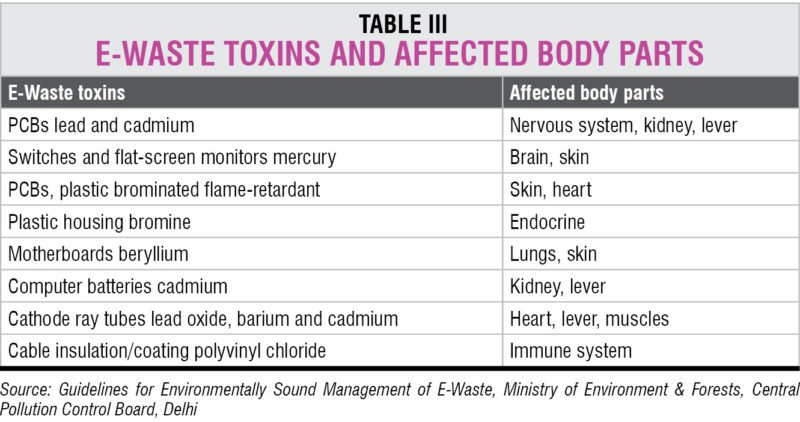
E-Waste (Management) Rules 2016, formulated by Ministry of Environment and Forest
Ministry of Environment and Forest has formulated and notified E-Waste (Management) Rules, 2016, to collect, dismantle and recycle all e-waste. The rules reflect commitment to environmental governance. The rules have, for the first time, included management of e-waste generated from disposal of mercury-containing compact fluorescent lamps, which are dangerous to the environment and health as these contain mercury.
New instruments of E-Waste Exchange, Deposit Refund Scheme and Extended Producer Responsibility have been introduced as incentives for consumers to voluntarily adopt the system of waste management. E-Waste Exchange offers sale and purchase of e-waste. If you as a consumer deposit end-of-life EEE, you will get a specified amount for the scrap.
Under Deposit Refund Scheme, the manufacturer will charge an additional amount as deposit at the time of sale, which will be returned to you along with interest when the end-of-life equipment is returned.
Under Extended Producer Responsibility scheme, manufacturers will be responsible for the collection and disposal of e-waste in an environmentally-sound manner. Other features of the rules are:
1. Rules are also applicable to components, consumables, spares and parts of EEE.
2. Collection target is set as 30 per cent of the waste generation during the first two years, 40 per cent during third and fourth years, 50 per cent during fifth and sixth years and 70 per cent seventh year onwards.
3. Responsibility to implement these rules lies with the state governments. They are responsible to ensure registration, skill development and monitoring to ensure safety and health of workers, and making available industrial space for e-waste dismantling.
4. e-Waste transporters need to carry a manifest prepared by the sender, giving all details.
5. Collection mechanism includes collection centre, collection point, take-back system and the like.
6. The refurbisher has to collect the e-waste generated during refurbishing and channelise it to the authorised dismantler or recycler.
7. There is liability for damages caused to the environment or third party due to improper management of e-waste; financial penalties to be imposed, where environmental degradation is happening.
8. The dealer, if given the responsibility on behalf of manufacturers, has to collect e-waste by providing the consumer a box for sending to the authorised dismantling centre.
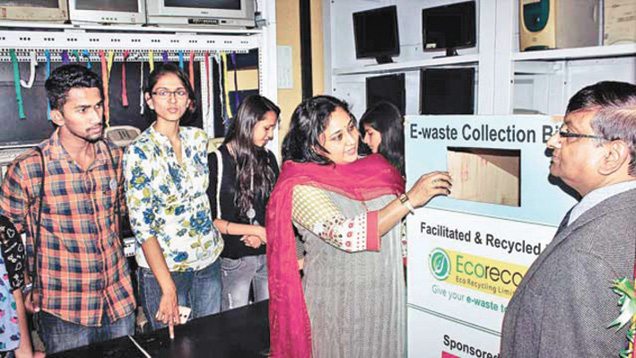
e-Waste and Basel Convention
India is a signatory to Basel Convention, which is a global agreement to handle waste to protect the environment and peoples’ health. The convention is the response of the international community to the problems caused by the annual worldwide production of 400 million tonnes of hazardous waste, which are toxic, poisonous, explosive, corrosive, flammable, eco-toxic or infectious. It addresses increasing concerns over the management, disposal and transboundary movements of hazardous waste, and puts obligations on to its parties to ensure that such waste is managed and disposed of in an environmentally-sound manner.
The convention was adopted in 1989 in Basel, Switzerland, and entered into force in 1992. Main principles of the convention are:
1. Trans-boundary movements of hazardous wastes should be reduced to a minimum consistent with their environmentally-sound management.
2. Hazardous waste should be treated and disposed of as close as possible to their source of generation.
3. Hazardous waste generation should be reduced and minimised at source.
Total number of ratifications to the convention stands at 63. Basel Convention Annex VIII refers to e-waste, which is considered hazardous under the convention.
Suggestions to prevent the e-waste crisis
Solution to this huge e-waste crisis lies in prevention rather than its control and management. A feedback loop needs to be created to product developers and designers to design end-of-life costs; for example, by making the product less toxic and more amenable to material recycling.
Recycling of e-waste is beyond the means of most consumers or local bodies, given its toxic nature. Manufacturers should therefore bear the responsibility for financing the scientific treatment of the e-waste, discarded by customers and be responsible for end-of-life costs.
Producer Responsibility Legislation for e-waste is already in force in developed countries such as EU, Japan, Korea, Taiwan and some American states. It is absolutely necessary that multinational companies treat all customers globally in the same way and create customer awareness for proper and correct disposal of their products and offer take back and recycling services in all countries—not just in countries where this is a legal requirement.
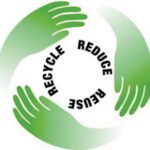
Manufacturers should take back their products once discarded by customers and ensure responsible recycling and disposal when products reach their end-of-life phase. Moreover, they should ensure a robust system of e-waste collection and treatment so that it is collected and recycled in a safe manner.
In our country the take-back programme is not working as well as it should, due to lack of an effective system, complex procedures and lack of awareness and education among customers.
Conclusion
Most people and businesses are not aware that properly disposing of or reusing EEE can help prevent health problems, create jobs and reduce environmental pollution and greenhouse-gas emissions. Reusing EEE needs to be encouraged and promoted. Reusing involves greater diversion of electronic waste from energy-intensive down-cycling processes (for example, conventional recycling), where equipment is reverted to raw material form.
Environmental and social benefits of reuse include diminished demand for new products and virgin raw materials (with their own environmental issues), availability of larger quantities of pure water and electricity for associated manufacturing, less packaging per unit, availability of technology to wider swaths of society due to greater affordability of products, and diminished use of landfills and effective management of hazardous waste, so as to avoid environmental pollution and adverse health effects due to its improper handling and disposal.
Col. B.C. Halan (Retd), M.Tech is advisor climate control services at KBS Certification Services, Faridabad






